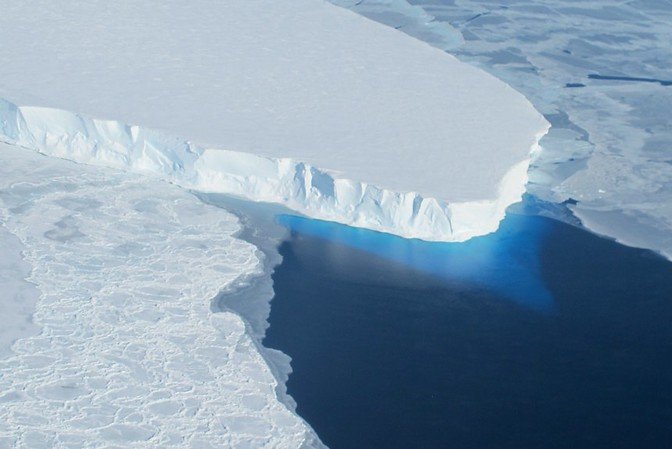The calving front of Thwaites Ice Shelf looking at the ice below the water's surface as seen from the NASA DC-8 on Oct. 16, 2012. Photo by NASA/James Yungel/
Flickr
Dec. 5 (UPI) -- The melting of the Thwaites Glacier is responsible for roughly 10 percent of current global sea level rise. The number would be higher if not for the Antarctic glacier's ice shelf, the part that floats atop the ocean and insulates thicker ice farther inland.
New research -- published this week in the journal Geophysical Research Letters -- suggests that once that protection is gone, the glacier's flow toward the ocean, and its subsequent breakup, is likely to accelerate.
To find out how quickly calving would accelerate the glacier's retreat in absence of its ice shelf, scientists ran 20 models designed to simulate two different calving mechanisms and ice front melting, melting that is concentrated along the glacier's front edge.
The models produced a variety of outcomes depending on the different scenarios. Simulations showed the glacier's ice losses could increase between 5 percent and 160 percent.
Under a worst-case scenario, Thwaites Glacier could disintegrate in just 60 years. More moderate scenarios suggest the glacier is likely to remain relatively stable for another century.
"Worst-case scenario, it is going to be gone in less than a century," lead study author Hongju Yu, an assistant specialist at the University of California, Irvine, said in a news release. "But it may also take much longer."
Thwaites Glacier itself is massive. If it collapsed, global sea levels could rise as much as two feet. But because the glacier lends structure and support to many surrounding glaciers, its collapse would likely accelerate the disintegration of neighboring Antarctic glaciers, causing additional sea level rise.
Thwaites is unique in its reliance on its ice shelf for stability. Without the ice shelf, the thicker ice within would collapse on itself and become exposed to warming ocean water.
Thwaites Glaicer is also uniquely vulnerable because its inland ice, beyond the grounding line where the bottom of its ice shelf connects to solid rock, the glacier slopes downward toward the middle of Antarctica. If ocean water breaches the grounding line, it could flow inland and melt the glacier from beneath.
As the glacier continues to melt, and its grounding line shifts farther inland, scientists suspect Thwaites will eventually reach a point of no return -- with its collapse inevitable. Currently, a series of ridges are keeping its retreat from reaching this point of no return. But scientists predict the grounding line is likely to migrate past the last ridge within the next 30 years.
"If you go past the ridge, then it's always in an unstable configuration," Yu said. "Even if you stop the ocean warming, the glacier will continue to retreat and lose mass rapidly."
Predicting the glacier's retreat is difficult, as its speed has varied wildly over time. By quantifying the effects of calving on the glacier's ice loss, the latest study can help scientists more accurately model Thwaites' retreat.
Modeling the future of the Thwaites Glacier is essential to predicting future sea level rise.
"The rapid collapse is a worst case, but we did not know until this study that it could happen as soon as the next 60-70 years," Yu said. "If the glacier does not collapse within these next 60-70 years, it will continue losing mass for centuries, just not as rapidly."















